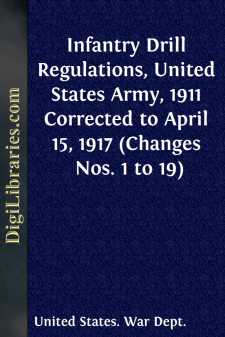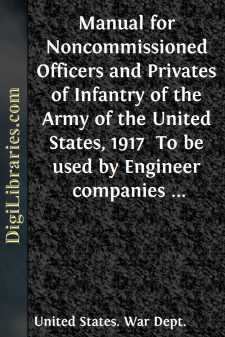Categories
- Antiques & Collectibles 13
- Architecture 36
- Art 48
- Bibles 22
- Biography & Autobiography 813
- Body, Mind & Spirit 142
- Business & Economics 28
- Children's Books 15
- Children's Fiction 12
- Computers 4
- Cooking 94
- Crafts & Hobbies 4
- Drama 346
- Education 46
- Family & Relationships 57
- Fiction 11829
- Games 19
- Gardening 17
- Health & Fitness 34
- History 1377
- House & Home 1
- Humor 147
- Juvenile Fiction 1873
- Juvenile Nonfiction 202
- Language Arts & Disciplines 88
- Law 16
- Literary Collections 686
- Literary Criticism 179
- Mathematics 13
- Medical 41
- Music 40
- Nature 179
- Non-Classifiable 1768
- Performing Arts 7
- Periodicals 1453
- Philosophy 64
- Photography 2
- Poetry 896
- Political Science 203
- Psychology 42
- Reference 154
- Religion 513
- Science 126
- Self-Help 84
- Social Science 81
- Sports & Recreation 34
- Study Aids 3
- Technology & Engineering 59
- Transportation 23
- Travel 463
- True Crime 29
Infantry Drill Regulations, United States Army, 1911 Corrected to April 15, 1917 (Changes Nos. 1 to 19)
Description:
Excerpt
INTRODUCTION.
1. Success in battle is the ultimate object of all military training; success may be looked for only when the training is intelligent and thorough.
2. Commanding officers are accountable for the proper training of their respective organizations within the limits prescribed by regulations and orders.
The excellence of an organization is judged by its field efficiency. The field efficiency of an organization depends primarily upon its effectiveness as a whole. Thoroughness and uniformity in the training of the units of an organization are indispensable to the efficiency of the whole; it is by such means alone that the requisite teamwork may be developed.
3. Simple movements and elastic formations are essential to correct training for battle.
4. The Drill Regulations are furnished as a guide. They provide the principles for training and for increasing the probability of success in battle.
In the interpretation of the regulations, the spirit must be sought. Quibbling over the minutiæ of form is indicative of failure to grasp the spirit.
5. The principles of combat are considered in of these regulations. They are treated in the various schools included in only to the extent necessary to indicate the functions of the various commanders and the division of responsibility between them. The amplification necessary to a proper understanding of their application is to be sought in .
6. The following important distinctions must be observed:
(a) Drills executed at attention and the ceremonies are disciplinary exercises designed to teach precise and soldierly movement, and to inculcate that prompt and subconscious obedience which is essential to proper military control. To this end, smartness and precision should be exacted in the execution of every detail. Such drills should be frequent, but short.
(b) The purpose of extended order drill is to teach the mechanism of deployment, of the firings, and, in general, of the employment of troops in combat. Such drills are in the nature of disciplinary exercises and should be frequent, thorough, and exact in order to habituate men to the firm control of their leaders. Extended order drill is executed at ease. The company is the largest unit which executes extended order drill.
(c) Field exercises are for instruction in the duties incident to campaign. Assumed situations are employed. Each exercise should conclude with a discussion, on the ground, of the exercise and principles involved.
(d) The combat exercise, a form of field exercise of the company, battalion, and larger units, consists of the application of tactical principles to assumed situations, employing in the execution the appropriate formations and movements of close and extended order.
Combat exercises must simulate, as far as possible, the battle conditions assumed. In order to familiarize both officers and men with such conditions, companies and battalions will frequently be consolidated to provide war-strength organizations. Officers and noncommissioned officers not required to complete the full quota of the units participating are assigned as observers or umpires....



